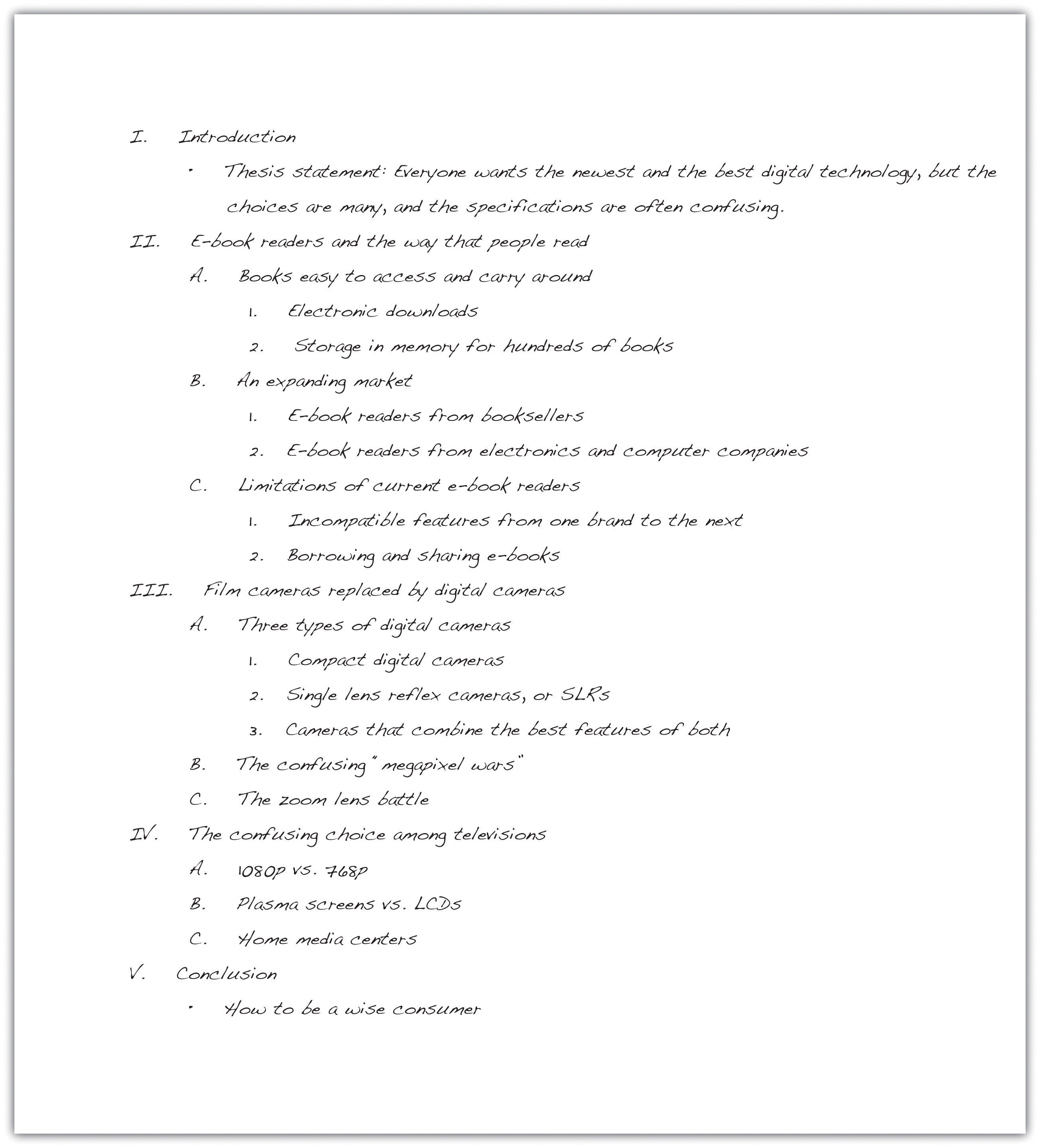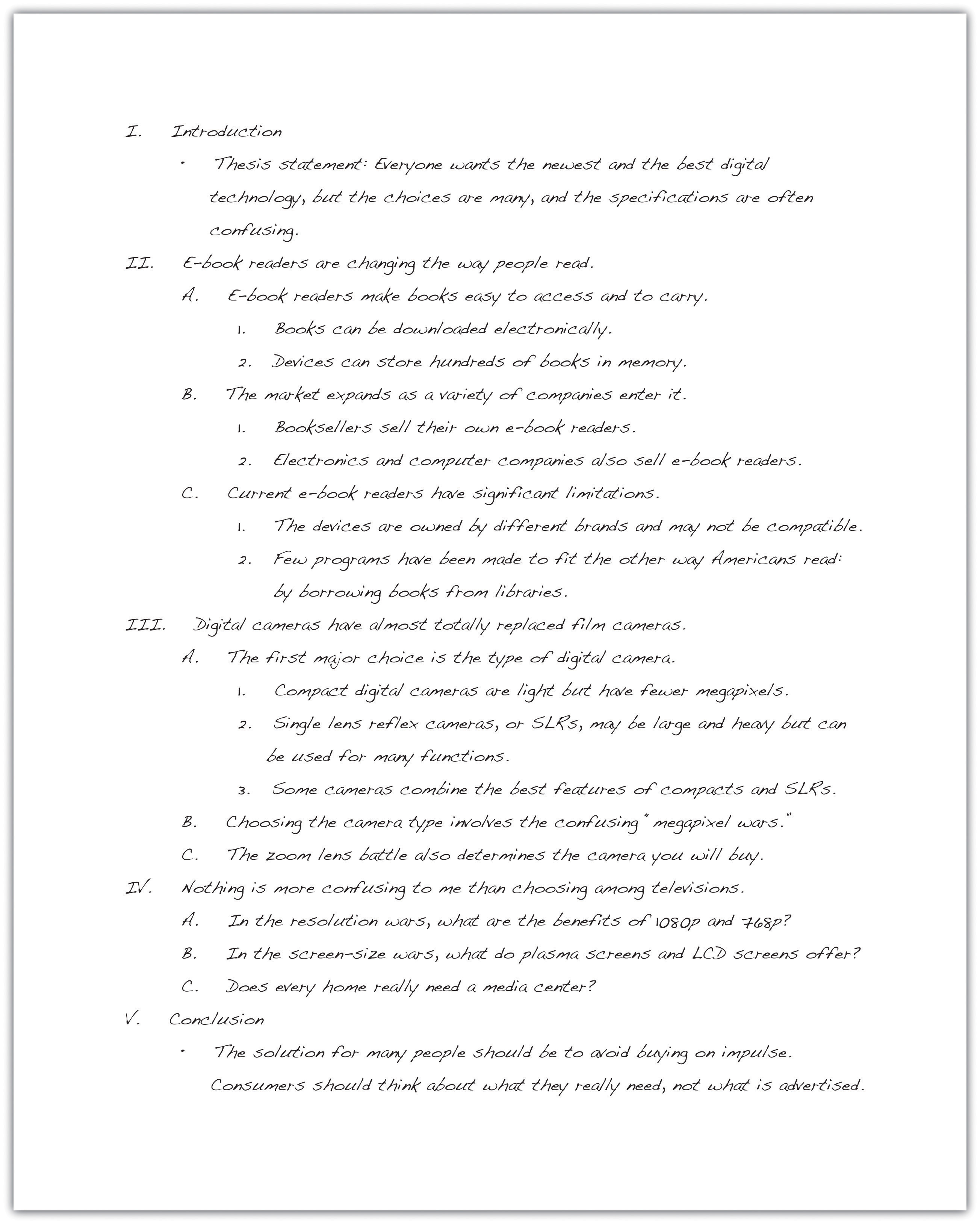4 Organize
This chapter is about the importance of organizing a draft with a clear outline. This step is sometimes combined with the previous step in the writing process—developing a thesis statement. Some writers find it helpful to first jot down their main ideas in outline form, and then use that visual to help develop an overarching thesis statement. Ultimately, moving from thesis statement to outline is dynamic: writers often develop an initial hunch, work out the kinds through an outline, and then revise the thesis each point becomes more obviously structured. This chapter, “Organize,” will stress the importance of planning and structure in the writing process.
The Importance of Organization
Your prewriting activities and readings have helped you gather information for your assignment. The more you sort through the pieces of information you found, the more you will begin to see the connections between them. Patterns and gaps may begin to stand out. But only when you start to organize your ideas will you be able to translate your raw insights into a form that will communicate meaning to your audience.
When you write, you need to organize your ideas in an order that makes sense. The writing you complete in all your courses exposes how analytically and critically your mind works. In some courses, the only direct contact you may have with your instructor is through the assignments you write for the course. You can make a good impression by spending time ordering your ideas.
Order refers to your choice of what to present first, second, third, and so on in your writing. The order you pick closely relates to your purpose for writing that particular assignment. For example, when telling a story, it may be important to first describe the background for the action. Or you may need to first describe a 3-D movie projector or a television studio to help readers visualize the setting and scene. You may want to group your support effectively to convince readers that your point of view on an issue is well reasoned and worthy of belief.
In longer pieces of writing, you may organize different parts in different ways so that your purpose stands out clearly and all parts of the paper work together to consistently develop your main point.
Methods of Organizing Writing
The three common methods of organizing writing are chronological order, spatial order, and order of importance. You need to keep these methods of organization in mind as you plan how to arrange the information you have gathered in an outline. An outline is a written plan that serves as a skeleton for the paragraphs you write. Later, when you draft paragraphs in the next stage of the writing process, you will add support to create “flesh” and “muscle” for your assignment.
When you write, your goal is not only to complete an assignment but also to write for a specific purpose—perhaps to inform, to explain, to persuade, or for a combination of these purposes. Your purpose for writing should always be in the back of your mind, because it will help you decide which pieces of information belong together and how you will order them. In other words, choose the order that will most effectively fit your purpose and support your main point.
Table “Order versus Purpose” shows the connection between order and purpose.
| Order | Purpose |
|---|---|
| Chronological Order | To explain the history of an event or a topic |
| To tell a story or relate an experience | |
| To explain how to do or make something | |
| To explain the steps in a process | |
| Spatial Order | To help readers visualize something as you want them to see it |
| To create a main impression using the senses (sight, touch, taste, smell, and sound) | |
| Order of Importance | To persuade or convince |
| To rank items by their importance, benefit, or significance |
For an essay question on a test or a brief oral presentation in class, all you may need to prepare is a short, informal outline in which you jot down key ideas in the order you will present them. This kind of outline reminds you to stay focused in a stressful situation and to include all the good ideas that help you explain or prove your point.
For a longer assignment, like an essay or a research paper, many college instructors require students to submit a formal outline before writing a major paper as a way to be sure you are on the right track and are working in an organized manner. A formal outline is a detailed guide that shows how all your supporting ideas relate to each other. It helps you distinguish between ideas that are of equal importance and ones that are of lesser importance. You build your paper based on the framework created by the outline.
Tip
Instructors may also require you to submit an outline with your final draft to check the direction of the assignment and the logic of your final draft. If you are required to submit an outline with the final draft of a paper, remember to revise the outline to reflect any changes you made while writing the paper.
Topic and sentence outlines
There are two types of formal outlines: the topic outline and the sentence outline. You format both types of formal outlines in the same way.
- Place your introduction and thesis statement at the beginning, under roman numeral I.
- Use roman numerals (II, III, IV, V, etc.) to identify main points that develop the thesis statement.
- Use capital letters (A, B, C, D, etc.) to divide your main points into parts.
- Use arabic numerals (1, 2, 3, 4, 5, etc.) if you need to subdivide any As, Bs, or Cs into smaller parts.
- End with the final roman numeral expressing your idea for your conclusion.
Here is what the skeleton of a traditional formal outline looks like. The indention helps clarify how the ideas are related.
-
Introduction
Thesis statement
-
Main point 1 → becomes the topic sentence of body paragraph 1
-
Main point 2 → becomes the topic sentence of body paragraph 2
-
Main point 3 → becomes the topic sentence of body paragraph 3
-
Conclusion
Tips
In an outline, any supporting detail can be developed with subpoints. For simplicity, the model shows them only under the first main point.
Formal outlines are often quite rigid in their organization. As many instructors will specify, you cannot subdivide one point if it is only one part. For example, for every roman numeral I, there must be a For every A, there must be a B. For every arabic numeral 1, there must be a 2. See for yourself on the sample outlines that follow.
Topic outlines
A topic outline is the same as a sentence outline except you use words or phrases instead of complete sentences. Words and phrases keep the outline short and easier to comprehend. All the headings, however, must be written in parallel structure.
Here is the topic outline that Mariah constructed for the essay she is developing. Her purpose is to inform, and her audience is a general audience of her fellow college students. Notice how Mariah begins with her thesis statement. She then arranges her main points and supporting details in outline form using short phrases in parallel grammatical structure.

Checklist
Writing an Effective Topic Outline
This checklist can help you write an effective topic outline for your assignment. It will also help you discover where you may need to do additional reading or prewriting.
- Do I have a controlling idea that guides the development of the entire piece of writing?
- Do I have three or more main points that I want to make in this piece of writing? Does each main point connect to my controlling idea?
- Is my outline in the best order—chronological order, spatial order, or order of importance—for me to present my main points? Will this order help me get my main point across?
- Do I have supporting details that will help me inform, explain, or prove my main points?
- Do I need to add more support? If so, where?
- Do I need to make any adjustments in my working thesis statement before I consider it the final version?
Writing at Work
Word processing programs generally have an automatic numbering feature that can be used to prepare outlines. This feature automatically sets indents and lets you use the tab key to arrange information just as you would in an outline. Although in business this style might be acceptable, in college your instructor might have different requirements. Teach yourself how to customize the levels of outline numbering in your word-processing program to fit your instructor’s preferences.
Exercise 4.1
Using the working thesis statement you wrote in the previous chapter, “Thesis Statements,” and the results of your brainstorming from “Generating Ideas,” construct a topic outline for your essay. Be sure to observe correct outline form, including correct indentions and the use of Roman and arabic numerals and capital letters.
Collaboration
Please share with a classmate and compare your outline. Point out areas of interest from their outline and what you would like to learn more about.
Sentence Outlines
A sentence outline is the same as a topic outline except you use complete sentences instead of words or phrases. Complete sentences create clarity and can advance you one step closer to a draft in the writing process.
Here is the sentence outline that Mariah constructed for the essay she is developing.

Tip
The information compiled under each roman numeral will become a paragraph in your final paper. In the previous example, the outline follows the standard five-paragraph essay arrangement, but longer essays will require more paragraphs and thus more roman numerals. If you think that a paragraph might become too long or stringy, add an additional paragraph to your outline, renumbering the main points appropriately.
Writing at Work
PowerPoint presentations, used both in schools and in the workplace, are organized in a way very similar to formal outlines. PowerPoint presentations often contain information in the form of talking points that the presenter develops with more details and examples than are contained on the PowerPoint slide.
Exercise 4.2
Expand the topic outline you prepared in the previous execise to make it a sentence outline. In this outline, be sure to include multiple supporting points for your main topic even if your topic outline does not contain them. Be sure to observe correct outline form, including correct indentations and the use of Roman and arabic numerals and capital letters.
Key Takeaways
- Writers must put their ideas in order so the assignment makes sense. The most common orders are chronological order, spatial order, and order of importance.
- After gathering and evaluating the information you found for your essay, the next step is to write a working, or preliminary, thesis statement.
- The working thesis statement expresses the main idea that you want to develop in the entire piece of writing. It can be modified as you continue the writing process.
- Effective writers prepare a formal outline to organize their main ideas and supporting details in the order they will be presented.
- A topic outline uses words and phrases to express the ideas.
- A sentence outline uses complete sentences to express the ideas.
- The writer’s thesis statement begins the outline, and the outline ends with suggestions for the concluding paragraph.

